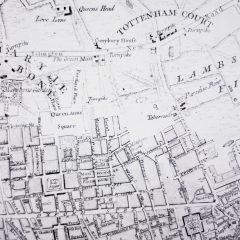https://news.fitzrovia.org.uk/category/history/
Warren Street was one of the most important second-hand car markets in London until well after the Second World War, busily trading from the 1920s. This used car market was a slightly shabby neighbour of the upmarket car showrooms clustered in Great Portland Street, with their displays of shining new models. For many local residents like May Thomas, Warren Street, not Great Portland Street, “was the centre of all the cars … You would walk in one end and by the time you come out the other end you would have your car.”i Today, a Volvo car showroom on the corner of Warren Street is the market’s last echo.
The used car market first began in 1912 when Friswell’s second-hand car auction rooms opened in Euston Road. Traffic soon grew on the main road, making it hard to park the stock. So, dealers started to use Warren Street, just behind Euston Road, to store their used cars. By 1930 Cass’s Motor Mart and five other car dealers were located in Warren Street, and by 1950 there were fifteen, including the specialist American Autos Limited.
The second-hand car market greatly helped those not in the ‘respectable’ salaried occupations necessary to obtain a car on Hire Purchase. Working-class consumers sometimes shared the purchase of a car with family or friends. Lower-income car buyers like these might also work in transport sectors or have close connections who did so and who could help with buying and maintaining a car.
The numerous registered dealerships on Warren Street were supplemented by casual street dealers who kept no paperwork, sealing a deal with just a handshake. After the War, the market attracted discharged servicemen who couldn’t find a job. With these street dealers the buyer had to beware. Some years before this, a columnist in the Illustrated London News had warned prospective buyers against so-called ‘crashes’, or “attractive looking cars of aristocratic descent which have unfortunately met with disaster and been patched up … Be very careful about these. Deal only with firms which have a reputation to lose and never with those which have one to make – of the proper sort, I mean.”ii Unsuspecting customers could sometimes be sold a bad bargain like this on the pavement in Warren Street.
The shadow car market in Warren Street was also quietly selling new cars; a most unwelcome activity to the dealers in the established market for new cars a stone’s throw away in Great Portland Street. The established car trade was badly hit by the War, and was in no condition to take any form of competition, let alone rule-bending, from the Warren Street traders. And it hit back with court cases: the Times for 21 December 1948 reports a case brought against some pavement traders, “Salvadori and others”, by the British Motor Trade Association, concerning breaches of its motor car covenants imposed to prevent car owners selling their new cars within twelve months. New cars were in very short supply just after the War and this encouraged an illicit trade where Warren Street dealers would pay above list price to those prepared to sell to them, then sell them on to customers willing to pay up to twice the list price.
The dealers argued in court that they were legitimate competition for the established car market, but the judge rejected their claim, adding that he “had suffered from a spate of false evidence” and that some of the documents in the case “were melancholy touchstones of mendacity.”iii He granted an injunction restraining them from dealing in new cars in breach of covenant and ordered them to pay costs.
The market’s reputation also suffered by association with the murder of one of the street car dealers, Stanley Setty. The accused was Brian Donald Hume, known in the market as “the flying smuggler”; he was a pilot, and had dropped Setty’s body parts from a plane. The headless and legless body was found dumped on Tillingham marshes in Essex on 21 October 1949. Hume was actually cleared of the murder: after being given a retrial because the first jury couldn’t agree a verdict he was sentenced instead to 12 years in prison for being an accessory after the fact.
After Setty’s murder, the Warren Street market had become a continuing focus of police interest and media attention, with a Picture Post article of 19 November 1949 homing in on the market’s daily business in an article entitled “Car Dealers of Warren Street”. The illustrations present almost a gangster image of the street traders, showing unsmiling men in mackintoshes and Trilby hats gathered in deep conversation next to a car or lingering on the corner of Warren Street and Fitzroy Street.
The disdainful tone of the whole piece was shown in the final paragraph:
It is this constantly presented two-sided aspect of Warren Street, its trade and its people, which is rather confusing. We found a host of people who were frank, open and honest. But we ran into strange silences when we asked the standard of current prices. Or how a dealer could buy a car he had never seen over the phone, and confidently see it at a profit by the next telephone call. (27)
The Picture Post article gave its middle-class readers a strategically heightened view of an ‘exotic’ corner of urban life that comes across as superciliously negative about the whole market. The suspicion that emanates from the newspaper article might be connected with a prejudice against the working-class, non-establishment traders, some of them immigrants, who were undermining a bigger car trade that clearly had its own price cartel. Whatever dubious dealings took place in some parts of Warren Street, its importance as a used-car market for sixty or more years tells us that many Londoners, and non-Londoners too, trusted it to provide them with private means of transport at a time when other sources were beyond their reach.
